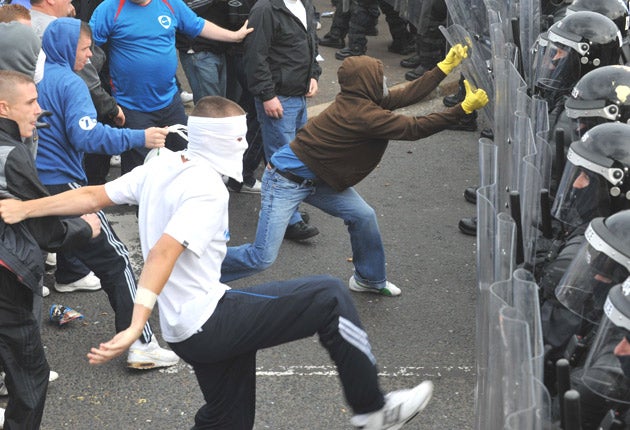Violence echoes beyond the streets of Belfast

Your support helps us to tell the story
From reproductive rights to climate change to Big Tech, The Independent is on the ground when the story is developing. Whether it's investigating the financials of Elon Musk's pro-Trump PAC or producing our latest documentary, 'The A Word', which shines a light on the American women fighting for reproductive rights, we know how important it is to parse out the facts from the messaging.
At such a critical moment in US history, we need reporters on the ground. Your donation allows us to keep sending journalists to speak to both sides of the story.
The Independent is trusted by Americans across the entire political spectrum. And unlike many other quality news outlets, we choose not to lock Americans out of our reporting and analysis with paywalls. We believe quality journalism should be available to everyone, paid for by those who can afford it.
Your support makes all the difference.Belfast is once again counting the cost – human, financial and social – of the familiar mid-July outbreak of disorder which has injured dozens of people and brought destruction onto its streets.
The Police Service of Northern Ireland (PSNI) has suffered most this year with more than 80 of its officers hurt by petrol bombs, bricks and other missiles, and in one case by a shotgun blast. In one potentially serious incident, an attempt was made in Lurgan, Co Armagh, to hijack and burn the Enterprise train which runs between Belfast and Dublin. The driver managed to steer his train out of trouble and there were no injuries.
Northern Ireland's image worldwide has been seriously damaged by television images of rioting and burning vehicles. Such graphic pictures of turbulence seem to make a mockery of the Irish peace process.
This year the disorder has also led to striking signs of differences within the authorities, with senior police officers pointedly calling on politicians to act with more urgency to tackle parading disputes. The political response is that this is "unacceptable". In other recriminations, criticisms were levelled at the police themselves, the Orange Order and Sinn Fein.
Although many of the televised scenes were dramatic, the impression is that the overall level of disturbance has not been higher than that of most recent years. The exception to this is the high number police injuries. Officers appear to have been targeted by republican dissidents, the main source of this year's violence. Almost everywhere, the hundreds of parades staged on the 12th of July, the climax of the Orange marching season, took place without incident. Most of the isolated outbreaks of violence took place in districts housing pockets of dissident republicans who oppose Sinn Fein and the peace process.
As usual, the most heated clashes took place at the flashpoint of Ardoyne in north Belfast. This year republican dissidents, many of whom sympathise with active terrorist groups such as the Real IRA, had encouraged supporters to travel there to stage protests.
Violence elsewhere tended to be sporadic, but dissidents remain active at a more lethal level. At the weekend they detonated a substantial bomb beneath a south Armagh road, leaving a large crater. While no one was injured, it was clearly part of determined attempts to kill members of the security forces. Three soldiers died in a similar attack close to the same spot in the 1970s.
Dissident leaders will probably be satisfied that their efforts to promote rioting produced television pictures which many viewers will assume is evidence that much of Northern Ireland remains in turmoil. A common outsider's view was given yesterday by Shauna Nugent, an American who was travelling by train from Dublin to Belfast.
She asked plaintively: "What is going on with Northern Ireland? Everybody is so nice but when this season comes around, it brings the worst out of people and it's just a shame. It does not need to go round the world – this place [and] the people have been through too much and it needs to stop."
The PSNI's Assistant Chief Constable, Alastair Finlay, declared: "Northern Ireland cannot afford to have violent images beamed across the world every summer – images which are totally unrepresentative of the vast majority of people who have embraced a peaceful and vibrant future."
He criticised Stormont's First Minister, Peter Robinson, and Deputy First Minister, Martin McGuinness, saying: "There are individual politicians working very hard on this, but... are we seeing the First Minister or the Deputy First Minister stepping out to condemn this and showing that they will have a plan to meet this issue next time it comes round, rather than waiting until it inevitably comes next year?"
In a sharp response, Mr Robinson described the remarks as "unhelpful and unacceptable". He added: "We must keep our entire focus on defeating those who would seek through violence and destruction to drag us back."
Sinn Fein also condemned the violence, saying the Ardoyne trouble had been caused by "anti-social elements" who had previously been involved in rioting elsewhere. Mr McGuinness added: "We are currently consulting on legislation that aims to provide a workable framework for dealing with contentious parades."
Join our commenting forum
Join thought-provoking conversations, follow other Independent readers and see their replies
Comments